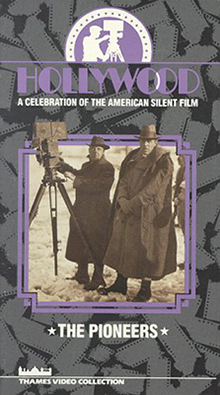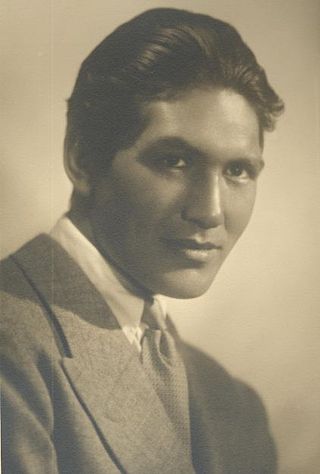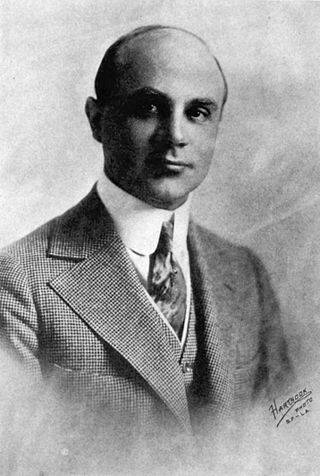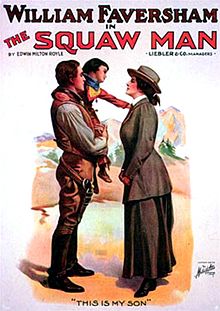
Cecil Blount DeMille was an American filmmaker and actor. Between 1914 and 1958, he made 70 features, both silent and sound films. He is acknowledged as a founding father of American cinema and the most commercially successful producer-director in film history. His films were distinguished by their epic scale and by his cinematic showmanship. His silent films included social dramas, comedies, Westerns, farces, morality plays, and historical pageants. He was an active Freemason and member of Prince of Orange Lodge #16 in New York City.
The year 1914 in film involved some significant events, including the debut of Cecil B. DeMille as a director.

The Hollywood Heritage Museum, also known as the "Hollywood Studio Museum," is located on Highland Ave. in Hollywood, California, United States.

Hollywood is a British television documentary miniseries produced by Thames Television and originally broadcast on ITV in 1980. Written and directed by film historians Kevin Brownlow and David Gill, it explored the establishment and development of the Hollywood studios and their cultural impact during the silent film era of the 1910s and '20s. At the 1981 BAFTA TV Awards, the series won for Best Original Television Music and was nominated for Best Factual Series, Best Film Editing and Best Graphics.

Jesse Louis Lasky was an American pioneer motion picture producer who was a key founder of what was to become Paramount Pictures, and father of screenwriter Jesse L. Lasky Jr.

Dustin Lancy Farnum was an American singer, dancer, and actor on the stage and in silent films. Although he played a wide variety of roles, he tended toward westerns and became one of the bigger stars of the genre.

Ray Mala was a prominent Native American Hollywood actor. He was one of Hollywood's Native American movie actors along with Lillian St. Cyr, Jesse Cornplanter, Chief Yowlachie, William Eagle Shirt, and Will Rogers who also had successful careers during that time. Mala's career peaked in the 1930s and he was best known for his lead role in Republic Pictures' 14-part serial Robinson Crusoe of Clipper Island (1936) following his feature role in MGM's Eskimo, directed by Woody Van Dyke. He was named a "Top Ten Alaskan" by TIME Magazine in 2009.

The Virginian is a 1914 American silent Western film based on the 1902 novel The Virginian by Owen Wister. The film was adapted from the successful 1903–04 theatre play The Virginian, on which Wister had collaborated with playwright Kirke La Shelle. The Virginian starred Dustin Farnum in the title role, a role he reprised from the original play. It was directed by Cecil B. DeMille.

The Squaw Man is a 1931 American pre-Code Western film directed by Cecil B. DeMille. It was his third time filming the same play but the first in sound. It stars Warner Baxter in the leading role.

Oscar C. Apfel was an American film actor, director, screenwriter, and producer. He appeared in more than 160 films between 1913 and 1939, and also directed 94 films between 1911 and 1927.

Joan the Woman is a 1916 American epic silent drama film directed by Cecil B. DeMille and starring Geraldine Farrar as Joan of Arc. The film premiered on Christmas Day in 1916. This was DeMille's first historical drama. The screenplay is based on Friedrich Schiller's 1801 play Die Jungfrau von Orleans. This film was considered to be the "first cinematic spectacle about Joan of Arc."

The Squaw Man is a 1918 American silent Western film directed by Cecil B. DeMille. It is a remake of DeMille's 1914 film of the same name, which is based upon a 1905 play by Edwin Milton Royle. The film was reportedly made as an experiment to prove DeMille's theory that a good film is based on a good story. It cost $40,000 to make and grossed $350,000. It would be remade again by DeMille in 1931.

The Squaw Man is a 1905 western/drama stage play in four acts written by Edwin Milton Royle.

James Young Deer, also known as J. Younger Johnson or Jim Young Deer, was actually born James Young Johnson in Washington, D.C. Although he was identified in the early Hollywood trade paper Moving Picture World as of the Winnebago Tribe of Nebraska, his ancestry is of the Nanticoke people of Delaware. He became an early film actor, director, writer, and producer. He is believed to be the first Native American filmmaker/producer in Hollywood. Together with his wife and partner Lillian St. Cyr, Winnebago, the couple were labeled an "influential force" in the production of one-reel Westerns during the first part of the silent film era. Their films, along with several others of the silent era, were notable for portraying Native Americans in a positive light.

White Fawn's Devotion: A Play Acted by a Tribe of Red Indians in America is a 1910 American short dramatic silent film. Although a few writers believe the film features Young Deer's wife, Lillian St. Cyr, otherwise known as Princess Red Wing as "White Fawn", the lead woman does not fit St. Cyr's description. IMDb now identifies the lead actress as Lucille Young. The movie was shot in New Jersey at 24fps.

Wilfred Buckland was an American art director. Buckland worked as an art director with Cecil B. DeMille and Jesse Lasky, and later with Alan Dwan, from 1914 to 1927. He was Hollywood's first "art director" and is credited with a number of advancements in filmmaking, including the advances in lighting techniques, the development of architectural sets, and the use of miniature sets. In 1924, he was named one of the ten individuals who had contributed the most to the advancement of the motion picture industry since the time of its inception. A 1980 exhibition at the Victoria and Albert Museum in London advanced the argument that "everything we know as 'Hollywood' traces to Wilfred Buckland." Buckland was among the first inductees in the Art Directors Guild Hall of Fame.

Red Wing was an American actress of the silent era. She and her husband James Young Deer have been dubbed by some as one of the first Native American Hollywood "power couple(s)" along with Mona Darkfeather and her actor/director husband Frank E. Montgomery. St. Cyr was born on the Winnebago Reservation in Nebraska.

Braveheart is a 1925 American silent contemporary Western film directed by Alan Hale Sr. and starring Rod La Rocque. The story focuses on members of a tribe of Indians who are being intimidated by the owners of a canning company seeking to violate a treaty protecting the tribe's fishing grounds. Braveheart is a remake of the 1914 film Strongheart directed by James Kirkwood Sr. and produced by the American Mutoscope and Biograph Company.
The Circus Man is a 1914 silent film produced by Jesse Lasky and distributed by Paramount Pictures. It was directed by Oscar Apfel and written by Cecil B. DeMille from a story based on the novel The Rose in the Ring by George Barr McCutcheon. It is preserved at the Library of Congress.
Cameo Kirby is a 1914 American drama silent film directed by Oscar Apfel and written by Clara Beranger and William C. deMille. The film stars Dustin Farnum, Fred Montague, James Neill, Jode Mullally, Winifred Kingston and Dick La Reno. It is based on the play Cameo Kirby by Booth Tarkington and Harry Leon Wilson. The film was released on December 24, 1914, by Paramount Pictures.


















